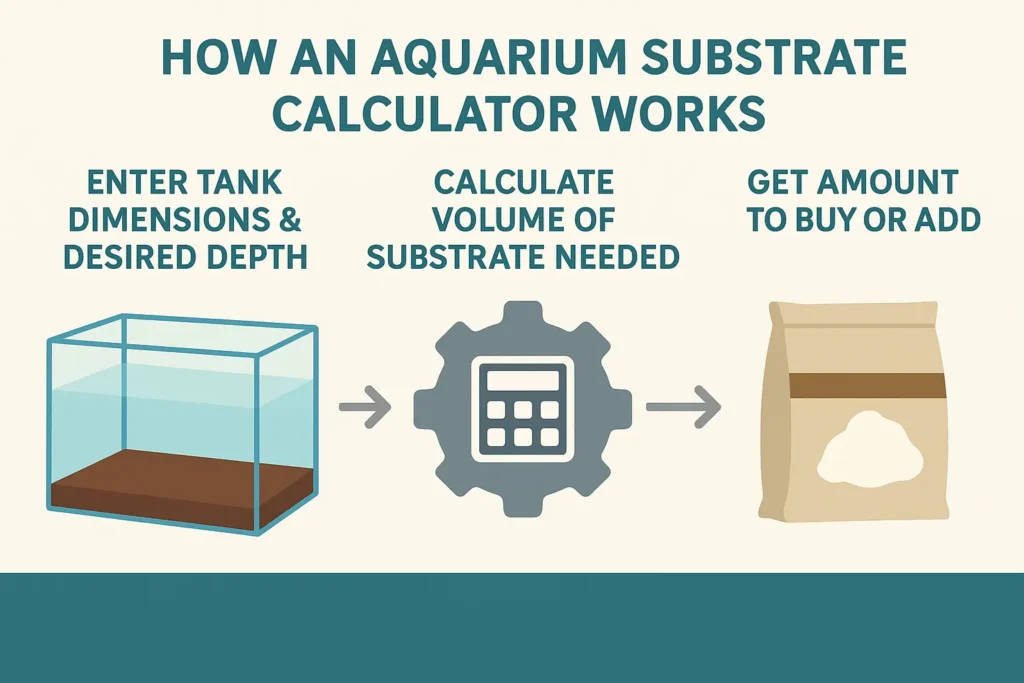💧 Aquarium Substrate Calculator
Calculate exactly how much sand, gravel, or soil your tank needs—based on shape, dimensions, and depth. Perfect for planted and fish-only aquariums.
Tank Setup
Select your aquarium's shape to get accurate volume.- For planted tanks, use at least 2-3 inches of aquasoil or enriched substrate.
- Fish-only tanks can do well with 1-2 inches of gravel or sand.
- Don’t forget to rinse your substrate thoroughly before adding it to the tank!
📦 Substrate Summary
Fill out the dimensions above to get a detailed summary of your aquarium substrate needs.
Aquarium Substrate Calculator

Created by James S. Lockwood
With a background in botany and ecological sciences, James specializes in creating practical tools and resources to help gardeners, farmers, and plant enthusiasts optimize their green spaces.
Instantly calculate how much gravel, sand, or soil your tank needs—plus cost estimates based on top brands.
Our aquarium substrate calculator helps you accurately estimate how much substrate you need based on your tank’s dimensions and setup. It removes guesswork and avoids common mistakes like using too little or overbuying. Instead of relying on rough rules or eyeballing it, this tool gives you a precise volume tailored to your tank size, shape, and substrate type—so you can set up your aquascape right the first time.
You could eyeball it. Many do. Some even use the vague “1 pound per gallon” rule—but that hardly accounts for different tank shapes, substrate types, or planting needs. And let’s face it, the last thing you want is to run out of substrate halfway through a messy aquascape session.

Table of Contents
How to Use the Aquarium Substrate Calculator?
Our aquarium substrate calculator was designed with simplicity in mind, but it’s robust enough for advanced planners. First, you select the tank shape—rectangular, bow front, or cylinder. It’s surprising how often calculators ignore non-standard tanks, even though bow fronts are pretty common in planted aquariums.
Then you enter the tank dimensions and the depth of substrate you want. For planted tanks, that’s usually 2 to 3 inches. For fish-only tanks, some argue even an inch is enough, although others claim anything under two inches invites more problems than it solves. It’s debatable—and that’s the point.
Next, select your substrate type: gravel, sand, or aquasoil. The calculator will display the required volume in liters, estimated weight in kilograms, and even give you an option to compare bag sizes and costs from popular brands. ADA, Seachem, Fluval—each has different densities and packaging, and the substrate cost estimator breaks it down for you.
Need to know exactly how much gravel your tank needs? Use our dedicated Aquarium Gravel Calculator for quick and precise results.
How Deep Should Aquarium Substrate Be?
Ask five aquarists and you’ll get five different answers. Some swear by a solid 3-inch base for rooted plants. Others insist on thinner layers to avoid anaerobic pockets. And for shrimp tanks, it’s a whole other discussion—soft fine substrate at about 1.5 inches is often preferred to mimic their natural habitat.
Still, a good rule of thumb is:
Fish-only tanks: 1 to 2 inches
Planted tanks: 2 to 3 inches
Shrimp tanks: around 1.5 to 2 inches with fine-grain aquasoil or sand
That said, personal preference, tank size, and maintenance habits often override these standards.
Not sure about your tank’s volume? Try our Fish Tank Volume Calculator to get exact gallon/liter measurements before estimating substrate.
Aquarium Substrate Depth Table
📏 Tank Size vs. Substrate Needed
Tank Size: 10 Gal (20x10")
Recommended Depth: 2"
Substrate Needed: ~5.5 L / ~8.3 kg
Tank Size: 20 Gal Long (30x12")
Recommended Depth: 2.5"
Substrate Needed: ~9.8 L / ~14.5 kg
Tank Size: 29 Gal (30x12")
Recommended Depth: 2.5"
Substrate Needed: ~11.5 L / ~17 kg
Tank Size: 40 Gal Breeder (36x18")
Recommended Depth: 3"
Substrate Needed: ~19.8 L / ~29 kg
Tank Size: 55 Gal (48x13")
Recommended Depth: 2.5"
Substrate Needed: ~20.5 L / ~30 kg
Tank Size: 75 Gal (48x18")
Recommended Depth: 3"
Substrate Needed: ~28.3 L / ~42 kg
⚠️ Estimates based on typical tank footprints and aquasoil density (~1.5 kg/L).
Gravel vs Sand vs Aquasoil: Which Should You Use?
Gravel is easy to clean and doesn’t cloud water much. It’s often the go-to for beginners. But its chunkier size means root-feeding plants may struggle, unless you use root tabs.
Sand gives a natural riverbed look, but it compacts easily. Some believe that leads to dead zones; others argue it’s fine with enough circulation. Corydoras and loaches love it, so it wins points for bottom-dwellers. If you’re using sand instead of gravel, head over to our Aquarium Sand Calculator for accurate substrate estimates by tank size and depth.
Aquasoil is nutrient-rich and perfect for planted aquariums, but it’s pricier. Some say it clouds the water, others say it clears after a few days. The real divide is between aesthetics and utility. If you’re serious about aquascaping, it might be worth the investment.
Use the aquarium substrate calculator to explore all three and weigh their cost, volume, and weight side by side. Sometimes the “cheaper” option ends up costing more in the long run due to extra bags or poor plant growth.
Want to dive deeper into how substrates affect aquatic systems? Read this detailed substrate guide from the University of Florida IFAS Extension.
Substrate for 10, 20, and 55 Gallon Tanks

Many users ask, “How much gravel do I need for my 20-gallon tank?” It depends on dimensions, not volume. A tall tank needs less than a long one. Use our fish tank substrate calculator to get precise results.
That said, for quick reference:
10-gallon: ~4–6 liters for 2″ depth
20-gallon long: ~9–12 liters
55-gallon: up to 25 liters if planted heavily
- Again, this varies based on shape and substrate type. The substrate depth calculator factors all this in for you.
Compare Aquarium Substrate Bag Costs
Let’s talk money. A bag of ADA Amazonia might seem steep at $30, but it goes a long way. Meanwhile, cheaper gravel might require more bags and still fall short for plant growth.
Our substrate cost estimator lets you plug in your preferred brand and see exactly how many bags you’ll need—and what it’ll cost. If nothing else, it prevents the dreaded “back to the store” scenario mid-setup.
Not sure how long to wait before replanting aquatic plants? Learn the best timing for root recovery and tank stability.”
How This Aquarium Substrate Calculator Works?
This calculator estimates the amount of substrate (gravel, sand, or aquasoil) you need based on your aquarium’s shape and size:
Volume Calculation:
Rectangular & Bowfront Tanks:
Length × Width × Substrate Depth= volume in cubic inchesCylinder Tanks:
π × (Diameter ÷ 2)² × Depth= volume in cubic inchesAll volume is then converted to liters (1 cubic inch ≈ 0.0163871 liters)
Weight Estimation:
Each substrate type has an average density:
Gravel ≈ 1.5 kg per liter
Sand ≈ 1.6 kg per liter
Aquasoil ≈ 1.1 kg per liter
Total weight =
Volume in liters × Substrate Density
Bag & Cost Estimation (optional):
You select a substrate brand
The tool divides your total volume by the bag’s volume
Total cost = bags × price per bag
FAQ: Your Top Substrate Questions Answered
How much substrate do I need for my aquarium?
It depends on tank size, shape, and desired depth. Use our aquarium substrate calculator to get an exact number in liters and kg.
Can I mix different types of substrate?
Yes, but be strategic. Heavy gravel will sink through sand over time. Some aquarists layer aquasoil under sand for aesthetics, but that risks mixing over time.
Is more substrate always better?
Not necessarily. Too much can trap waste and make cleaning difficult. Too little and plants won’t anchor well. The sweet spot lies in planning—and using a calculator.
Is substrate even necessary for a fish-only tank?
Technically no—but most would say yes for aesthetic reasons and to host beneficial bacteria. Bare-bottom tanks are functional but sterile looking.
Do I need substrate in a fish-only aquarium?
While not strictly necessary, substrate in fish-only tanks supports beneficial bacteria and improves aesthetics. Some hobbyists prefer bare-bottom tanks for easier cleaning, but most choose gravel or sand.
How many bags of substrate do I need for a 55-gallon tank?
It depends on the bag size and your desired depth. Use the Aquarium Substrate Calculator to input your tank dimensions and get the exact number of bags needed based on brand packaging.
What’s the difference between gravel and aquasoil?
Gravel is inert and easy to clean, making it great for fish-only tanks. Aquasoil is nutrient-rich and ideal for planted tanks, but it may cloud the water initially and is typically more expensive.
Substrate might not be the flashiest part of your tank, but it sets the stage for everything that follows. Guessing isn’t just inefficient—it’s expensive. And frustrating.
Use our aquarium substrate calculator to avoid the guesswork. Whether you’re using gravel, sand, or aquasoil, knowing the right amount and expected cost helps you plan better and enjoy the process more.
It may not seem like much, but the right substrate—at the right depth—can be the difference between a tank that thrives and one that struggles.
Tips for Planted Tanks
Use nutrient-rich substrate like aquasoil or capped dirt for long-term plant health—especially for root feeders like Amazon swords or crypts.
Aim for 2–3 inches of depth in planted zones to anchor roots and allow proper nutrient absorption.
Layering works: Some aquarists add a base layer of organic soil or clay additives and top it with gravel or sand to control leaching and compaction.
Rinse inert substrates (like Fluval Stratum or Seachem Flourite) to reduce initial cloudiness.
Avoid coarse gravel—plants struggle to root, and it traps debris that can decay and spike ammonia.
Don’t skip lighting and fertilization. Good substrate helps, but healthy growth still depends on balanced light and water column nutrients.
Disclaimer
This Aquarium Substrate Calculator provides an estimate based on standard formulas and average substrate densities. Actual results may vary based on substrate brand, compaction, rinsing loss, and aquascaping style. Always double-check packaging instructions and consult with your local aquarium supplier for specific recommendations.
